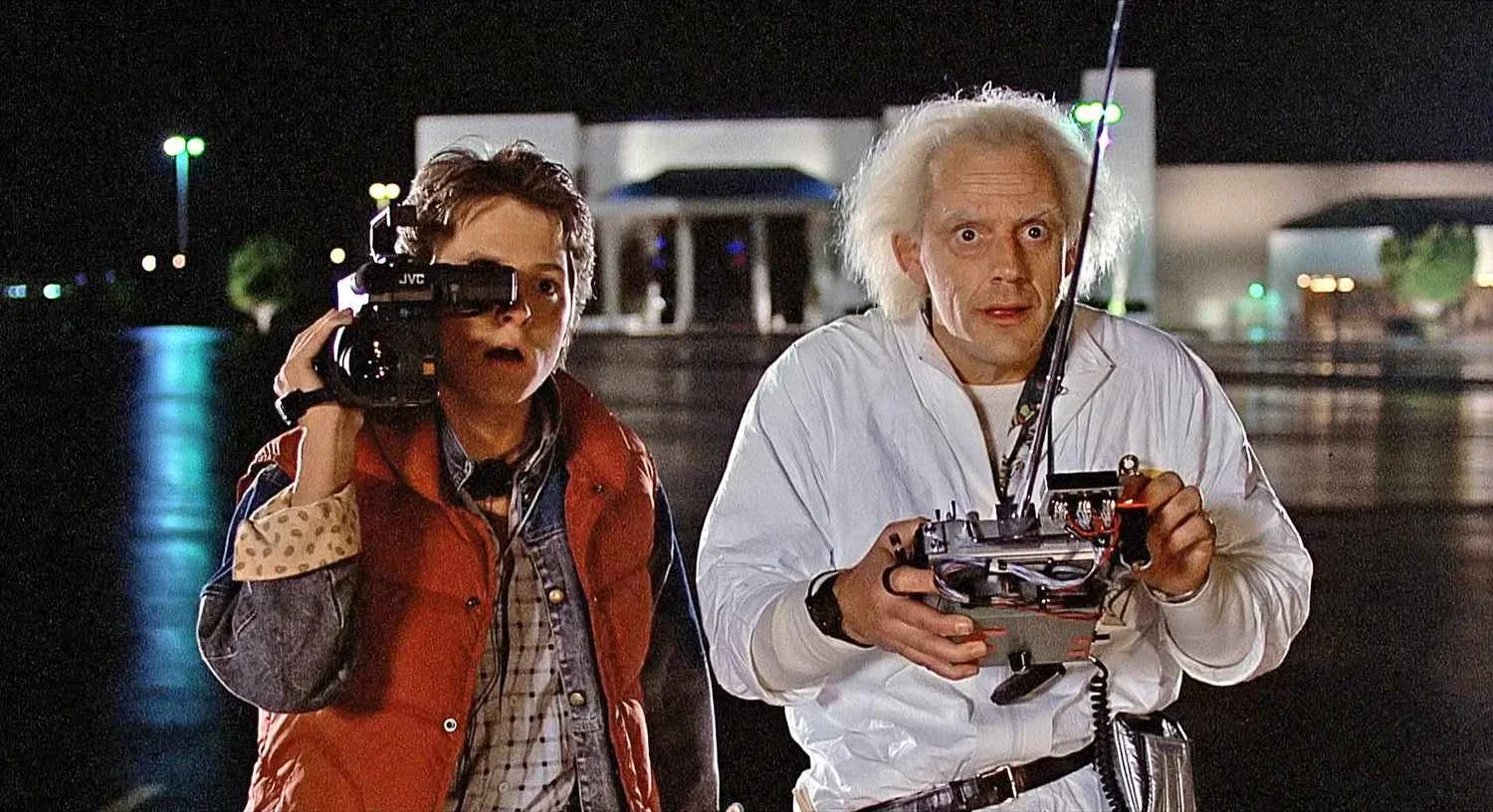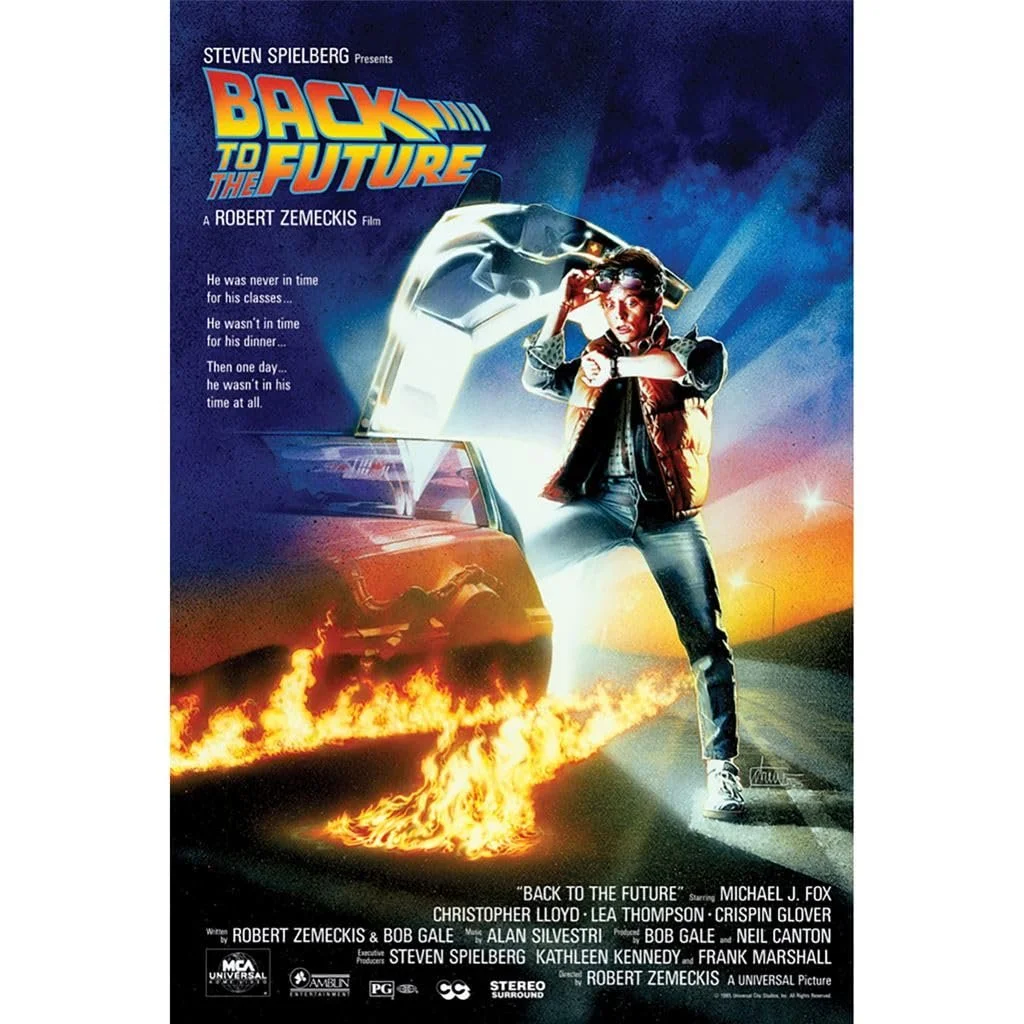Back to the Future
(Robert Zemeckis, 1985)
⭐️⭐️⭐️⭐️ 1/2
There is an adage in screenwriting that says, “You have to show Kansas before you show Oz”. Of course, this is in reference to “The Wizard of Oz”, and how the impact of that film is heightened by showing the desolation and drabness of Dorothy’s Kansas before she gets to the majestic and magical land of Oz. Generally speaking, this saying is simply about how if you’re placing a character in a fantastical setting, it is best to show their normal and mundane everyday environment. The fantastical setting is then heightened, and stakes are established, especially if the story is about the protagonist’s return home. “Back to the Future”, the time traveling blockbuster film from Robert Zemeckis, makes the the year 1985, awash in decay and stagnation, Kansas while the year 1955, bristling with innocence and promise, stands in as Oz. Zemeckis throws two curveballs into the whole dynamic when he proposes, “What would happen if you got to know your parents while they were in high school?” and “What would you do if you had the opportunity to prevent something tragic from happening?”.
“Back to the Future” tells the story of Marty McFly (Michael J. Fox), a high school student in Hill Valley, California with lofty dreams of being a musician but reality has other plans. He is deemed a slacker by his high school principal, Mr. Strickland (James Tolkan), and his band is unceremoniously dismissed when auditioning for a gig playing at the school dance. Marty’s home life could also be much better. His mother Lorraine (Lea Thompson) is an alcoholic, and his father George (Crispin Glover) is a cowardly nerd who still bends to the commands of his high school bully, Biff Tannen (Thomas Wilson). The only bright spots in Marty’s life are his girlfriend Jennifer (Claudia Wells), and his friendship with local eccentric scientist Dr. Emmett Brown (Christopher Lloyd).
It is Marty’s friendship with “Doc” Brown that sets the wheels in motion for the film’s plot to get going. Doc creates a time machine out of a DeLorean, and he has Marty document the first test run. Things are complicated when Libyan terrorists, who has been ripped off by Doc and a glaring indication of the film’s time, interrupt the event. Things are further complicated when Marty escapes in the DeLorean and accidentally travels back in time to 1955. Things are complicated once more when Marty runs into his parents, prevents them from falling in love, and threatens his own existence. With the help of 1955’s Doc Brown, Marty must find a way to get back into his own time while also making sure his parents become his parents.
All great films start with the script, and the script for “Back to the Future” is razor sharp and seemingly air tight. This look at “Back to the Future” really will focus on the script and story structure. Zemeckis and his co-writer Bob Gale expertly break things down into three very distinct acts that all serve the purpose of keeping the story moving and making sure the stakes are always present in the minds of the audience. The biggest challenge they overcome with the script is in the first act because that act requires the most exposition to establish all the callbacks the film will payoff once the action switches to 1955. The first act also establishes the “rules” of the science fiction and time traveling that the film observes. Zemeckis buries all sorts of hidden guns, comedic and serious, during the first third of the film while also masterfully handling the large amounts of exposition. Cinematographer Dean Cundey films the opening of the film in one shot as we see Doc Brown’s home adorned in an array of foreshadowing clocks. This wonderful camera work from Cindy also immediately tells the audience enough information about Doc Brown and his recent activities, such as why a case of plutonium happens to be in the room. Further exposition that will be paid off takes place when Michael and Jennifer get a history of Hill Valley’s clock tower, and Lorraine tells the story of how her and George’s romantic beginnings. Once the film has to explain the time traveling dynamics, Zemeckis and Gale wisely decide to do so by having Doc Brown explain it in the form of a recorded demonstration. Doc Brown not only demonstrates things to Marty, but he demonstrates it to the audience as a whole.
While Zemeckis and Gale use the first act to lay out the exposition that will be paid off in the second and third acts of “Back to the Future”, they also take the time to show us “Kansas” in the form of Hill Valley in 1985. Simply put, the town has seen better days. The heart of Hill Valley is the clocktower in the courthouse located in the town square. That heart no longer beats in 1985 due to a historic lightning storm, and the town around it is not doing much better. A seediness, represented by the likes of graffiti, abandoned buildings, and “adult” establishments, permeates throughout Hill Valley, but it is accepted as the normal by its inhabitants. That is just the way things are in 1985, a full four years after actor turned politician Ronald Reagan found himself in the White House.
Once Marty finds himself back in 1955, the film’s Oz, it is presented as a nightmare of sorts on multiple fronts. Zemeckis shows all sorts of cultural signifiers to establishing 1955 as a simpler and more innocent time, but, for Marty, there is a looming sense of dread. He is not of this time. The people of 1955 are not ready for this weird teenager talking about some guy named John F. Kennedy and acting like he has already seen what Jackie Gleason is doing on television that particular week. Marty, like Dorothy, has to get home. Before Marty can get home, he has the added task of making sure his parents fall in love, especially since young Lorraine has started to fall for Marty and young George is too scared to make a move. Fox, who replaced Eric Stoltz well into production and filming, gives a star making performance that is a mix of sheer confusion about his surroundings, comedic terror about his mother’s romantic advances, and frustration with George’s true nature. The second act is really where Zemeckis explores the concept of what it would be like to know your parents in high school, especially the interactions between Marty and young George.
Everything Zemeckis and Gale sets up comes to a head in the film’s final act, which sees Marty attempting to get young George and Lorraine together at an important high school dance all while working with the 1955 version of Doc Brown to get back to 1985. The ticking clock aspect of the film really comes into play during this stretch as all sorts of last minute obstacles are thrown into the mix to add tension and doubt regarding the coupling of Marty’s parents and his efforts to get back to 1985. George saves Lorraine from a rather disturbing sexual assault at the hands of Biff, a moment that will make all anyone who suffered torment at the hands of a bully cheer, but George still has work to do. He has to kiss his future bride on the dance floor in order to make sure Marty exists in the future. When the romantic payoff finally happens, Cundey shoots it in a way where it seems George and Lorraine are the only people present on a dance floor filled with other students. The majestic score from Alan Silvestri helps us imagine the life the couple will soon make for themselves. This, of course, is all before we get a brief interlude where the film posits the music of Chuck Berry is the product of a white suburban California teenager from the future… playing the music of Chuck Berry.
With George and Lorraine’s future set in motion, a future that most definitely will experience some modifications, Marty must finally get back with Doc to initiate the plan to get back to 1985. The weight of what will happen to Doc the instant he returns weighs heavily on Marty to the point of trying to warn the 1955 version. Doc, being a man of science, refuses to accept the responsibility of tampering with the future before Zemeckis decides to throw some final complications into the elaborate plan to return Marty back to 1985 in the way of the DeLorean not starting and a tree falling on connecting cables. Marty’s success is never in doubt. The film, after all, is called “Back to the Future”, so, while the tension is there, the audience never questions whether or not Marty will return to 1985.
Zemeckis delivers quite a “twist” upon the audience when Marty does return to 1985. After a week or so in the squeaky clean Hill Valley of 1955, Marty is delighted to be back in the decaying Hill Valley of 1985. He is home, even if home is marked by bums sleeping on benches and porno theaters in the town square. The protagonist returns to Kansas, grateful to be back, and still attempts to prevent Doc from falling victim to terrorist gunfire. This is where Zemeckis, by way of 1985 Doc, just throws out all the worries and concerns the film has established about changing the timeline. It also sets up the final sequence in the film where Marty realizes this 1985 version of Hill Valley is not exactly the Hill Valley he knew. Because of his actions, which forced George to grow a spine and stand up to Biff in 1955, Marty made a better future for his family. George is a success. Lorraine is not an alcoholic. Marty’s siblings are well adjusted. Biff is the submissive coward, who got put in his place. Everyone is going to live happily ever after in this version of Ronald Reagan’s 1985, or are they? Is this a happy ending or a more cynical one from Zemeckis? Doc returns from the future to inform Marty and Jennifer about problems facing their children. There is not much time to spend back in Kansas because the film and its subsequent sequels must return to variations of Oz.
“Back to the Future”, now 40 years since its release, continues to resonate with audiences due to the great performances from its cast, a fantastic score, a story that remains evergreen even though it is steeped in nostalgia for two different decades, and a structure that is rock solid. Zemeckis takes all of this and runs with the opportunity to subvert expectations and feelings about both 1985 and 1955 culture. Those in the 1980s were nostalgic for the quaint times of the 1950s, but Zemeckis does not seem to be as nostalgic as one might suspect. The 1950s he presents seems perfect on the outside, but there are problems bubbling under the seems. The television invades the family dinner setting. Casual racism is a part of everyday life. Sexual assault seemingly happens as if it is nothing. The “good old days” might not have been as good as one might think they were. Oz might just be a facade, which is why one must always go back home to Kansas.
This review is part of my From the Vault series showcasing movies of the past I have decided to visit or revisit and review.





Chuck Russell’s 1988 remake of the original 1958 film is a prime example of something that would qualify as a B Movie that far surpasses its original source material.